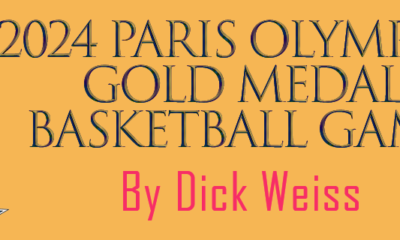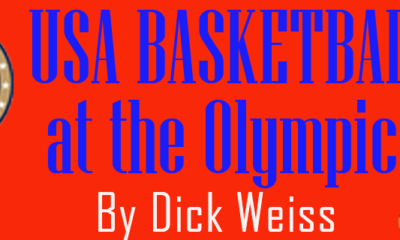HOUSTON– Oklahoma’s red hot shooting guard Buddy Hield has been on fire during the Sooners’ Final Four run, averaging 29.3 points, shooting 19 for 40 from beyond the three point arc and earning a salute from Kobe Bryant who was in the stands to watch him light up Pac-12 champion Oregon for 37 points last Sunday during his team’s 80-68 victory at the NCAA West Regional final in Anaheim.
He has even earned comparisons to Stephen Curry, the last player to have this type of iconic NCAA run when he played for Davidson’s Elite Eight team in 2008.
“I’m not even close to him,” Hield said. “He’s on a different level.”
Buddy is the biggest name in this Final Four and his NBA stock is rising before our very eyes. At last look, the 6-3 senior All American from Freeport in the Bahamas has sky rocketed to three in the mock NBA drafts, right behind forwards Ben Simmons of LSU and Brandon Ingram of Duke. He could go higher.
Hield is the one player on Villanova’s mind as the Wildcats prepare for a rematch against Oklahoma in the NCAA national semi-finals here at cavernous 71,000-seat NRG Stadium. This NFL arena has an elevated floor and no backdrop, which makes the court, essentially located at the 50-yard line of the football field, look like it was floating in an abyss. It has created serious depth perception problems for long range shooters in past NCAA events, especially the 2011 Final Four.
“It doesn’t bother me,” he said. “When I was younger, I used to shoot into a crate nailed to a homemade plywood backboard or on outside courts in the park where there’s palm trees and mango trees blowing. It shouldn’t bother. If you’re a good shooter, you shoot it.”
Hield, arguably the best pure shooter in the country, will provide the ultimate test for the NRG effect, which led to one of the all-time worst championship games when Connecticut defeated Butler, 53-41, and both teams put on a horrific shooting display, especially from outside the three point arc. Butler and Connecticut combined to shoot 31 for 119 (26 percent) and 10 for 44 (22.7 percent) from deep. Butler set a record for the lowest shooting percentage in a championship game with 18.8. The Bulldogs made just 2 of 31 two point attempts.
That game will live in infamy as will that Final Four. ntucky shot a combined 88 for 218 (38.6 percent) in the semi-finals. By any standard, those percentages were drastically below average.
The 2015 NCAA South Regional offered more evidence this particular Dome can be a nightmare for shooters when Gonzaga, Duke, UCLA and Utah shot a combined 26.7 from three point range in the renamed NRG Stadium during the three games . Duke shot 8 for 19 from the three against Gonzaga in the championship game. The regional semifinals were dreadful with Gonzaga hit only 3 of 19 from three against UCLA, it’s work percentage of the season; while Duke was only 3 of 9 against Utah, UCLA was 3 of 13 and Utah was 4 of 16.
If you believe in the “NRG effect,” those ugly shooting percentages should give North Carolina, Villanova, Oklahoma and Syracuse– the four teams in this year’s Final Four– pause as they prepare their game plan for the national semi-finals.
Villanova coach Jay Wright, for one, was happy to get three chances shots to shoot in this wide open environment.
“It’s something we talk to our guys about,” he said. “We got a closed practice in there today. We talked to our guys about you’ll get that experience today. First time you go in there. You got to see it, got to feel it. WE said, Hey, if your shots aren’t going in today, don’t worry about it, you’ll get used to it, don’t let it affect you.
“Friday, we get in here and probably 40,000 will be at the open practice. You get that experience. Then we get another shoot around Saturday. I told the guys, ‘By Saturday night, you’ll be fine. I don’t think it’s an issue.”
We’ll find out quickly.
Having three top-50 three-point shooting teams fight it out under the lights at NRG will do a lot to either dispel or confirm the NRG Effect.
The fact Carolina is the only team that doesn’t rely heavily on the three for its offense could give the top-seeded Tar Heels an edge playing in this venue since Carolina takes just 17.1 thees per game. The Tar Heels have scored 61.1 percent of its points this season inside the arc. That ranked fifth nationally, according to a study done by statistical analyst Ken Pomeroy. The Heels get 19.9 percent of their points from behind the three point line, which ranks 345th of 351 Division I teams. Of the other remaining teams, Villanova scores 33.4 percent of its points from the three (70th) Syracuse (36.5 percent (27th) and Oklahoma, which makes an average of 10 threes a game, 38.9 (14th).
“It might possibly gave us a slight advantage, because we get so many of our points at the basket,” Carolina senior guard Marcus Paige said. “It’s easier to make a layup in a different environment than a three.”
North Carolina, which defeated Syracuse twice in the regular season, will look to avoid a meltdown by continuing to rely on its inside game. “As a shooter you just try to get used to the background,” Paige said. “It’s weird. Even playing at Duke is different than playing in Chapel Hill because it’s a smaller setting.You’re got to get used to the lighting.”
Carolina’s only stadium experience has been playing at the 35,000-seat Carrier Dome in Syracuse.
“Which is kind of fitting I guess,” Tar Heels’ forward Justin Jackson said. “You have to get used to the depth perception, which is good we’re getting there early so we can do it.”
Syracuse will have the advantage of playing its home games in the Dome, so the impact of the NRG could be minimal for the Orange.
“I don’t think it will have an effect,” Syracuse coach Jim Boeheim said. “I’ve seen people come into our building and shoot 60 percent. I saw a kid from Charlotte come in and make 11 threes. Guys that can shoot can shoot anywhere. They can’t shoot outdoors. It doesn’t matter.”
That should be reassuring for Hield.
Related Topics
Dick Weiss is a sportswriter and columnist who has covered college football and college and professional basketball for the Philadelphia Daily News and the New York Daily News. He has received the Curt Gowdy Award from the Naismith Basketball Hall of Fame and is a member of the national Sportswriters Hall of Fame. He has also co-written several books with Rick Pitino, John Calipari, Dick Vitale and authored a tribute book on Duke coach Mike Krzyzewski.









